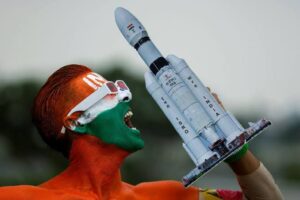India on a Historic Move to Touch Down Moon South Pole

India is on the verge of making history as it attempts to land a spacecraft on the moon’s south pole, a region that has never been explored by any other nation. The Chandrayaan-3 mission, which means “moon vehicle” in Sanskrit, is scheduled to touch down on the lunar surface on Wednesday, August 23, 2023, at 18:04 local time .
The mission is a follow-up to the Chandrayaan-2 mission, which failed to land on the moon in 2019 due to a loss of communication with the lander. The Indian Space Research Organisation (ISRO) has made several improvements and modifications to the Chandrayaan-3 lander, named Vikram, to ensure a smooth and successful landing this time.
The Chandrayaan-3 mission consists of an orbiter, a lander and a rover. The orbiter was launched on July 14, 2023, from the Satish Dhawan Space Centre in Sriharikota, India, using the Geosynchronous Satellite Launch Vehicle Mark-3 (GSLV Mk-III) rocket. The orbiter has been orbiting the moon since August 5, 2023, and will provide support and communication for the lander and the rover .
The lander and the rover separated from the orbiter on August 22, 2023, and began their descent towards the lunar south pole. The lander has been sending back images of the moon’s far side, showing craters and mountains that have never been seen before. The lander will use its thrusters to slow down and perform a soft landing on a flat area near the south pole. The rover, named Pragyan, which means “wisdom” in Sanskrit, will then roll out of the lander and explore the lunar terrain for about 14 Earth days.
The main objectives of the Chandrayaan-3 mission are to study the topography, mineralogy, surface chemistry and exosphere of the lunar south pole. The mission also aims to find evidence of water ice and other volatiles that may exist in the permanently shadowed regions of the moon. The mission carries several scientific instruments, including a seismometer, a thermal probe, an X-ray spectrometer and a laser-induced breakdown spectroscope. The mission also carries a retroreflector from NASA that will help measure the precise distance between the Earth and the moon.
If successful, Chandrayaan-3 will make India the first country to land on the lunar south pole and the fourth country to achieve a soft landing on the moon after the United States, Russia and China. The mission will also demonstrate India’s technological prowess and scientific ambition in space exploration. The mission has been widely praised and supported by Indians as well as international experts and enthusiasts.
The ISRO will livestream the landing event on its official website and social media platforms. Millions of people around the world are expected to watch and cheer for India’s historic moon mission.


